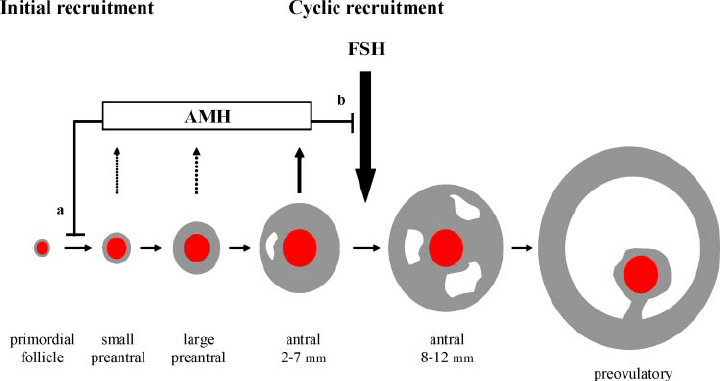“You may need an AMH test”
Either you’ve come across this sentence, or you’ve heard about the AMH test and want to know more.
Often, the AMH test is prescribed as a pre-screening test for individuals who are starting their IVF journey, or are simply wanting to know more about their fertility.
It’s a simple blood test that can be done at any point of the menstrual cycle. But there’s more to it than just values.
It’s information that helps you, your healthcare providers and helps tailor your fertility treatment.
But how exactly? And what do you need to know about AMH for your health?
Let’s dive in to know more!
Table of contents:
- What is AMH?
- When is AMH produced?
- How is AMH test conducted?
- What are normal AMH levels?
- Who is the AMH test for?
- How can an AMH test help?
What is AMH?
AMH, or Anti-Müllerian Hormone, is a vital biomarker in the field of reproductive medicine. This hormone, secreted by small, developing follicles in a woman’s ovaries, plays a crucial role in assessing ovarian reserve.
In simpler terms, AMH provides valuable insights into the number of eggs a woman has left in her ovaries. This, in combination with tests such as AFC can provide a broader overview of the ovarian reserve.
When is AMH produced?
The production of AMH begins in the early stages of fetal development and continues throughout a woman’s reproductive years. Importantly, post puberty, AMH levels in the blood remain relatively stable during the menstrual cycle, making it a reliable marker for assessing ovarian reserve.
In women, AMH production is highest during the primordial, pre Antral and small Antral stages. But as it grows further, AMH production decreases. Almost no AMH is produced in follicles over 8mm, which are about 1-3 follicles every month, competing to produce the “egg of the month”.

On the other hand, did you know AMH is produced in men too? Similar to the fetal stages in women, AMH is produced in the fetal stages and directs the male organs to grow in the mullerian ducts. For females, AMH directs the mullerian ducts to differentiate into the female reproductive organs!
How is AMH test conducted?
The AMH test is a minor blood test. A healthcare professional takes a small sample of blood from a vein in the arm and checks for the AMH levels.
There’s no specific requirements prior to the test. You can test AMH at any point of your menstrual cycle as the levels do not largely fluctuate during the cycle.
What are normal AMH levels?
Normal AMH levels range from 2-6.8ng/ml at any phase of the menstrual cycle. But this varies according to age and patient factors.
- High AMH levels- above 3-4 ng/ml [if there is consistent high levels, it may be an indicator of PCOS]
- Normal AMH levels- 1-2 ng/ml
- Low AMH levels- <1 ng/ml
Who is the AMH test for?

The AMH largely benefits doctors and embryologists who can then understand the patient’s ovarian reserve and tailor treatment plans for their cycles accordingly. In terms of patients this test can be beneficial for:
- Patients undergoing IVF: If you’re considering or undergoing IVF, AMH testing is crucial. It helps you have a better idea of your ovarian reserve, which in turn guides the IVF protocol, medication dosages, and timing for optimal results.
- Individuals considering fertility preservation: AMH testing is also valuable for those looking to preserve their fertility, such as cancer patients facing treatments that may affect their future fertility. Knowing your AMH levels can help you make informed decisions about egg or embryo freezing.
- Individuals who want to investigate their reproductive health: if you’re someone in their 20s and 30s looking to understand your fertility or reproductive health, AMH can be considered as a screening test that provides an idea of your ovarian reserve for you and your healthcare provider.
How can an AMH test help?
AMH testing is typically one of the most recommended screening tests to evaluate ovarian reserve. Apart from that, it also helps with:
- Predicting ovarian response in IVF: For patients undergoing IVF, AMH levels are a predictive tool. High AMH levels suggest a robust response to fertility medications, while low levels may indicate a more conservative response, influencing medication dosages and treatment strategies.
- Tailoring IVF treatment plans: AMH results enable embryologists and fertility specialists to customize IVF treatment protocols. A high AMH level may lead to adjustments like lower medication doses, while a low level may necessitate a different approach.
- Monitoring during fertility preservation: Women considering fertility preservation, such as egg freezing, can benefit from AMH monitoring. It helps track changes in ovarian reserve over time and guides the timing of the preservation procedure.
AMH is not just another acronym in the world of reproductive medicine; it’s a powerful tool that empowers both embryologists and IVF patients. By understanding what AMH is, who it’s for, and when it’s used, you can embark on your fertility journey with confidence and clarity. Whether you’re an embryologist fine-tuning treatment plans or a patient undergoing IVF or assessing their fertility, AMH can be a vital biomarker to help you navigate your journey.
Want to listen to this as a podcast instead? You can do so here 😎
